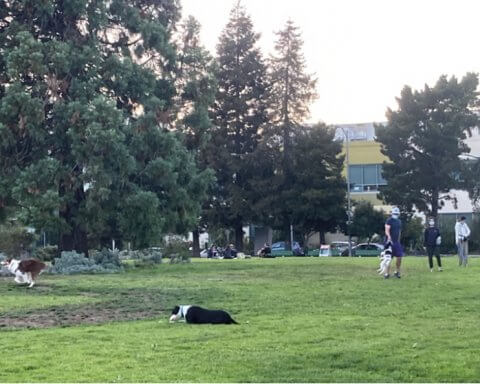In the face of sky-high construction costs and ongoing housing shortages, the San Francisco Municipal Transit Agency (SFMTA) wants to partner with a private developer to build upwards of 800 homes at its Potrero Yard when the bus facility is reconstructed over the next ten years.
The 104-year old facility, which spans a 4.4-acre block south of 17th Street and Franklin Square Playground, is structurally obsolete and needs to be completely rebuilt, which has opened the door for SFMTA to reimagine use of the space. The agency has held several community design workshops and formed the Potrero Yard Modernization Project Working Group, which has met four times since last December. But apart from the idea that housing be located above the bus station, there’s no design plan, architect or development partner yet.
“They are in the process of trying to determine what sort of project they are going to try to push for,” said J.R. Eppler, who represents the Potrero Boosters on the working group.
The housing concept puts the agency in uncharted territory. In the 2017 hiring contract for a consultant, Hatch Associates, to evaluate the viability of the idea, SFMTA noted it’d never “undertaken a public private partnership of this magnitude, and there appear to be few precedents in the United States for a combined bus yard/joint development facility.” What’s more, SFMTA hasn’t identified another instance anywhere in the world in which residences have been co-located with a bus station.
The idea to expand the yard beyond busses came from a 2013 SFMTA report, Real Estate and Facilities Vision for the 21st Century, which suggested complimentary non-transit uses for SFMTA property as a way to generate revenues. The study recommended that Potrero Yard be developed into a campus-type facility with technology and research activities above the bus station.
By the time SFMTA began taking steps to upgrade the site former Mayor Ed Lee had created the Public Land for Housing initiative, which directs City agencies to evaluate property they own for use as housing. SFMTA is currently working through that assessment process with the Planning Department, Office of Economic and Workforce Development and the Mayor’s Office of Housing and Community Development (MOHCD).
There’s been strong support for housing at community meetings, though determining the type, affordability, and height is more contentious. “A lot of people have said they would like significant affordability given that it’s a public facility,” said Eppler. “But that runs counter to SFMTA’s desire to pay for the project and balance those concerns.”
According SFMTA project manager, Licinia Iberri, $400 million is needed just to upgrade the bus yard. The agency won’t have that funding level even if voters approve a prospective bond measure in 2022, which could raise $250 million.
At least 25 percent of the housing would have to be affordable, the definition of which varies. Proposition K, passed in 2015, requires surplus City land used for housing to be at least 33 percent affordable – with a minimum of 15 percent set aside for households earning 55 percent or less of average median income (AMI); and at least 18 percent dedicated to those with incomes that’re 120 percent of AMI – but it’s unclear whether the facility, since it’ll still be in use, would fall under the definition of surplus land, thereby triggering the proposition’s requirements. To increase the amount of affordable housing SFMTA likely would need to secure additional funding through MOHCD.
Erick Arguello, a member of the Mission community organization Calle 24 who is on the working group, anticipates that there’ll be pressure to make all housing developed on the site affordable. “From working in the Mission all these years and seeing the changes, we’ve had 10,000 residents displaced, 8,000 of those Latinos, so we’re trying to stabilize the neighborhood and one of the ways of doing that is affordable housing,” he said. He also suggested that the project set aside housing for bus yard employees.
The bus facility is expected to need 70 feet for the first three stories; two stories currently exist. SFMTA has suggested adding as much as eight levels of housing above that.
Mary Haywood Sheeter, a working group member who represents Friends of Franklin Square, said residents are worried about potential park darkening. “The children’s playground is in the spot where if you were to build the maximum of bus plus housing it would shade the playground for kids some parts of the year. A lot more housing units would mean a lot more people coming to the park, which we’re not opposed to,” she said, adding that she’s pro-residences.
Sheeter believes that the project should be designed with the park in mind, related to such simple elements as adding a pedestrian crosswalk. “Right now, it’s a little dead around the bus yard,” she explained.
As part of the redesign SFMTA is considering adding 5,000 square feet for retail, community or production, distribution and repair service along Bryant Street.
Over the summer SFMTA intends to explore the necessary elements for the bus facility itself. “We want to answer questions about what Muni is doing in the building versus what other things might be on the site,” said Iberri. “We haven’t really talked about that.” She said the agency will offer public tours of the complex this month. “It will help us make the case for why we need to do it. It’s an old building so it tells the story pretty well of why we need to rebuild.”
The complex, known as the 17th Street Car House when it was built, houses 136 busses with 16 bus bays. SFMTA wants that to increase to 206 busses and 24 bus bays. The agency will likely begin looking for a development partner within the next year, with the idea of developing a comprehensive design by 2023 and starting construction thereafter, completing the new facility by 2026.


